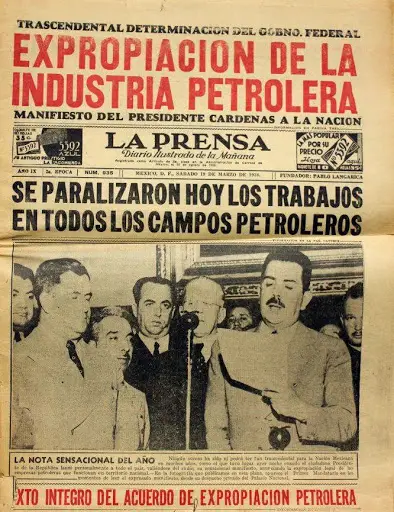Some Mexicans in the oil and gas industry celebrate Oil Expropriation Day with events to honor the sovereignty and national ownership of oil resources.
Oil Expropriation Day is a national observance in Mexico.
With oil being one of Mexico’s important resources, Mexican president Lázaro Cárdenas nationalized all oil reserves, facilities and oil companies on March 18, 1938. This was done in the best interest of Mexicans. Mexican state-owned petroleum company Petróleos Mexicanos (PEMEX) was established shortly after.
Prior to expropriation in 1938, the oil industry in Mexico had been dominated by the Mexican Eagle Company (a subsidiary of the Royal Dutch/Shell Company), which accounted for over 60% of Mexican oil production, and by American-owned oil firms including Jersey Standard and Standard Oil Company of California (SOCAL – now Chevron), which accounted for approximately 30% of total production. However, in Article 27 of the Constitution of 1917, the Mexican Government asserted ownership of the “subsoil,” including any natural resources discovered below ground. The possibility that the Mexican political leadership might exercise its rights complicated relations with the United States until the Calles-Morrow agreement of 1928, which temporarily alleviated tensions by reaffirming the rights of oil companies in the territories they had worked prior to 1917.

Despite the political difficulties, Mexico became the world’s second largest producer of oil in the 1920s. Nevertheless, the foreign-owned oil companies were the object of much popular resentment. Since Mexico was an agrarian nation with only a tiny domestic market, these companies exported most of the oil they produced during the 1920s and very little of their profits remained Mexico. The situation was exacerbated during the 1930s, when the Mexican Government’s share of oil revenues declined and domestic oil production dropped due to the Great Depression and a glut in the global oil supply. These developments, combined with the fact that the large oil companies often paid their Mexican workers only half as much as other employees working in the same capacity, ultimately led to massive labor unrest.
A strike by oil workers in 1937 ultimately led the Mexican Government to act. Initially, President Cárdenas attempted to mediate a settlement by having a government commission draw up a new labor agreement. After the foreign companies defied both the commission and the Mexican Supreme Court, however, Cárdenas promulgated the expropriation decree on March 18, 1938.

Efforts to secure the re-admission of the foreign oil companies in Mexico proved to be a failure, however. After Cárdenas left office in 1940, the Mexicans were willing to consider the possibility, but only on condition that Mexico retained ownership of the subsoil, and PEMEX its domestic monopoly. This proved unacceptable to both the U.S. Government and oil companies. Finally, in 1950, the U.S. Government abandoned its efforts to re-open the Mexican oil industry after several failed attempts to use government loans as leverage. By this time, American oil companies had begun losing interest in Mexico and preferred operating under the more favorable conditions found in the Middle East and Venezuela.


